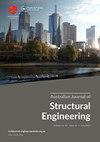Stability of beam-column by geometrically nonlinear analysis
IF 1.3
Q4 ENGINEERING, CIVIL
Australian Journal of Structural Engineering
Pub Date : 2023-05-17
DOI:10.1080/13287982.2023.2213506
引用次数: 0
Abstract
ABSTRACT Stiffness properties of structural members, such as beam, plate and shell, can change drastically in the presence of axial forces due to geometric effects of the nonlinear strain components. In this paper, the stability behaviour of beam-column is investigated using the governing differential equation and compared with the geometrically nonlinear finite element analysis. The lateral deflection obtained from the theoretical model matches quite accurately with the numerical values for wide range of axial to critical load ratio P/P cr . It is shown that bending stiffness decreases linearly with the axial load. By extending the theory, an expression for the membrane stiffness of the beam-column is presented in this paper. The geometrically nonlinear finite element analysis can capture exactly the parabolic variation of the membrane stiffness as per the derived expression. It increases initially up to P/P cr = 0.35 and decreases rapidly to negligible value near the critical load indicating buckling instability.梁柱的几何非线性稳定性分析
由于非线性应变分量的几何效应,梁、板和壳等结构构件的刚度特性在轴向力作用下会发生剧烈变化。本文利用控制微分方程研究了梁柱的稳定特性,并与几何非线性有限元分析进行了比较。在较宽的轴向-临界载荷比P/P cr范围内,理论模型得到的横向挠度与数值吻合较好。结果表明,弯曲刚度随轴向载荷的增加而线性减小。通过对理论的推广,给出了梁柱膜刚度的表达式。几何非线性有限元分析可以准确地捕捉到膜刚度的抛物线型变化。当P/P cr = 0.35时,该系数开始增大,但在临界载荷附近迅速减小至可忽略不计的值。
本文章由计算机程序翻译,如有差异,请以英文原文为准。
求助全文
约1分钟内获得全文
求助全文
来源期刊

Australian Journal of Structural Engineering
ENGINEERING, CIVIL-
CiteScore
2.50
自引率
0.00%
发文量
31
期刊介绍:
The Australian Journal of Structural Engineering (AJSE) is published under the auspices of the Structural College Board of Engineers Australia. It fulfils part of the Board''s mission for Continuing Professional Development. The journal also offers a means for exchange and interaction of scientific and professional issues and technical developments. The journal is open to members and non-members of Engineers Australia. Original papers on research and development (Technical Papers) and professional matters and achievements (Professional Papers) in all areas relevant to the science, art and practice of structural engineering are considered for possible publication. All papers and technical notes are peer-reviewed. The fundamental criterion for acceptance for publication is the intellectual and professional value of the contribution. Occasionally, papers previously published in essentially the same form elsewhere may be considered for publication. In this case acknowledgement to prior publication must be included in a footnote on page one of the manuscript. These papers are peer-reviewed as new submissions. The length of acceptable contributions typically should not exceed 4,000 to 5,000 word equivalents. Longer manuscripts may be considered at the discretion of the Editor. Technical Notes typically should not exceed about 1,000 word equivalents. Discussions on a Paper or Note published in the AJSE are welcomed. Discussions must address significant matters related to the content of a Paper or Technical Note and may include supplementary and critical comments and questions regarding content.
 求助内容:
求助内容: 应助结果提醒方式:
应助结果提醒方式:


